Macroeconomics Assignment: Economic Indicators and Labor Markets
VerifiedAdded on 2020/02/24
|7
|1005
|58
Homework Assignment
AI Summary
This macroeconomics assignment solution addresses several key concepts. It begins by calculating private, public, and national savings, along with net exports and investment, using provided GDP data. The assignment then delves into labor productivity, explaining its determinants and illustrating how human capital influences efficiency with a cooking analogy. Next, it analyzes a video comparing the US and China's economic trajectories, discusses the benefits of free trade for emerging economies, and clarifies the meaning of per capita income and the importance of adjusting it for inflation. Finally, the assignment examines the impact of automation and globalization on the Australian economy, discussing structural unemployment, job losses in the auto industry, and challenges faced by the younger generation in the job market. The solution references relevant economic literature to support its analysis.
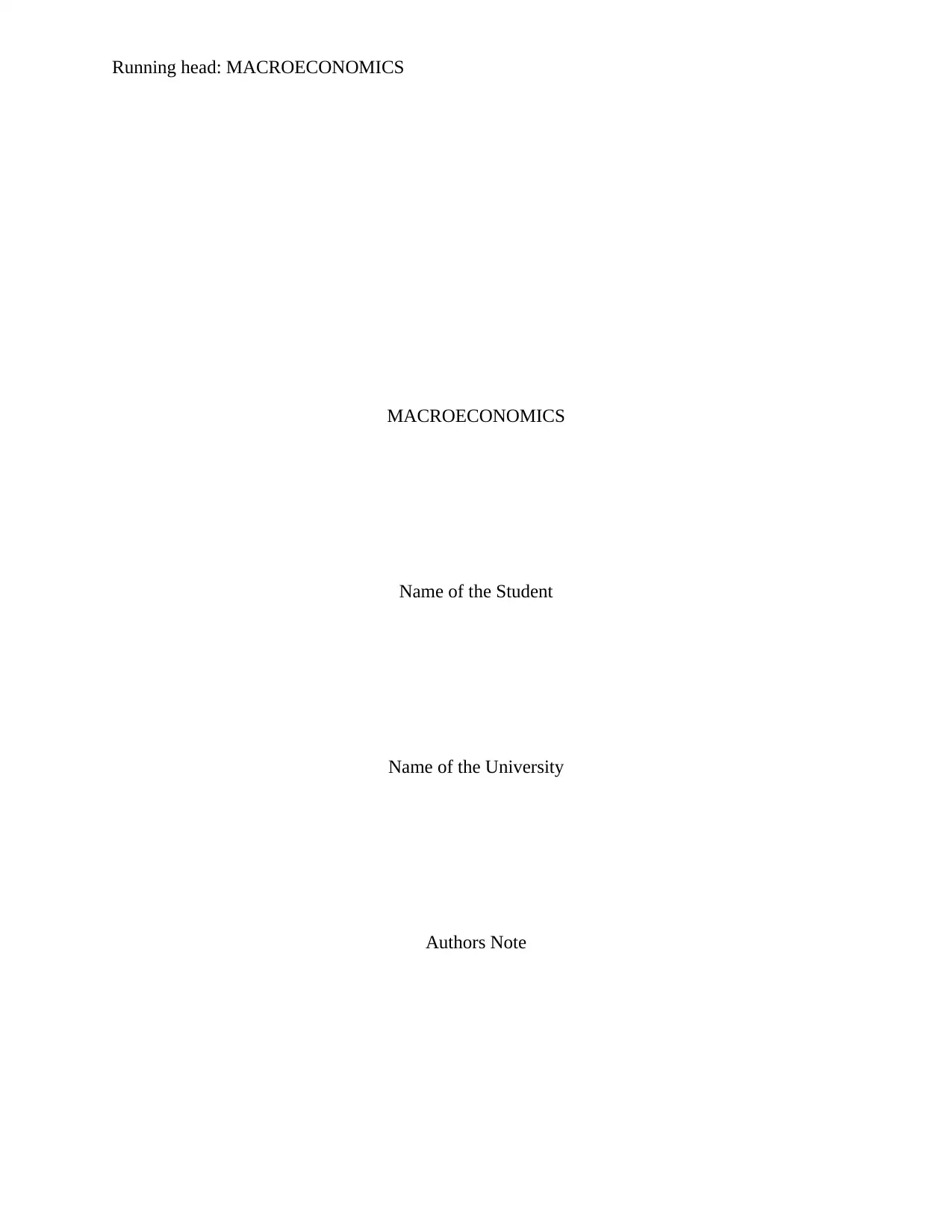
Running head: MACROECONOMICS
MACROECONOMICS
Name of the Student
Name of the University
Authors Note
MACROECONOMICS
Name of the Student
Name of the University
Authors Note
Paraphrase This Document
Need a fresh take? Get an instant paraphrase of this document with our AI Paraphraser
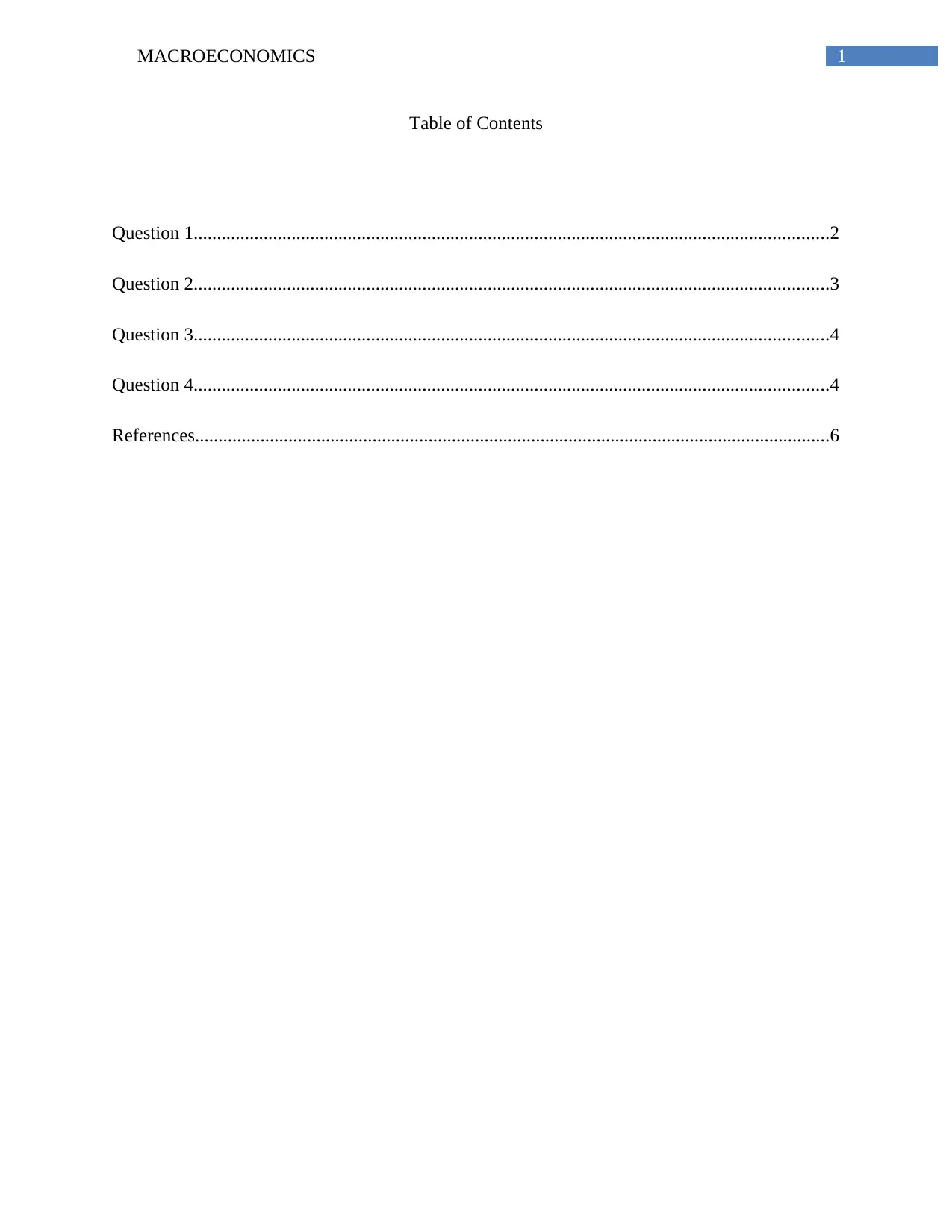
1MACROECONOMICS
Table of Contents
Question 1........................................................................................................................................2
Question 2........................................................................................................................................3
Question 3........................................................................................................................................4
Question 4........................................................................................................................................4
References........................................................................................................................................6
Table of Contents
Question 1........................................................................................................................................2
Question 2........................................................................................................................................3
Question 3........................................................................................................................................4
Question 4........................................................................................................................................4
References........................................................................................................................................6
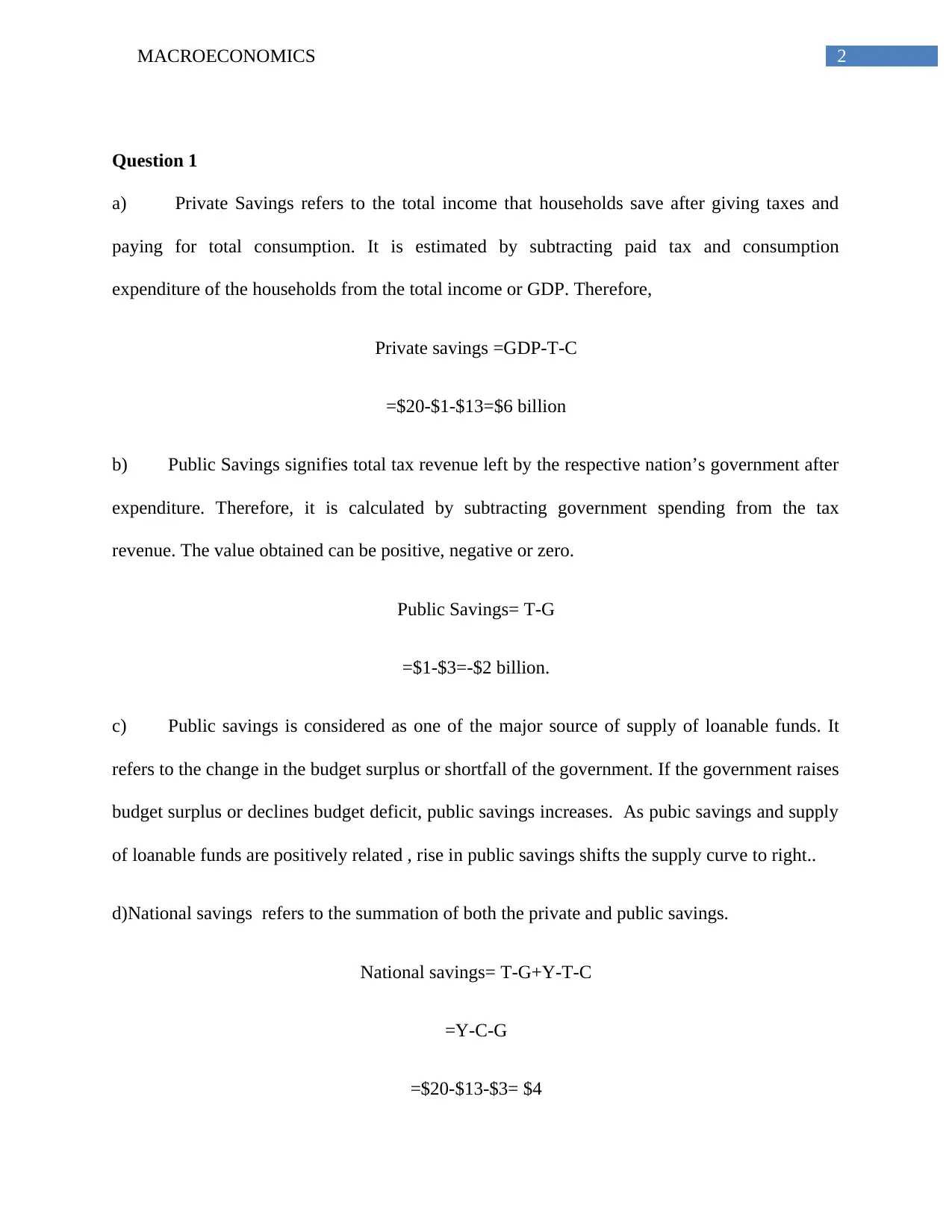
2MACROECONOMICS
Question 1
a) Private Savings refers to the total income that households save after giving taxes and
paying for total consumption. It is estimated by subtracting paid tax and consumption
expenditure of the households from the total income or GDP. Therefore,
Private savings =GDP-T-C
=$20-$1-$13=$6 billion
b) Public Savings signifies total tax revenue left by the respective nation’s government after
expenditure. Therefore, it is calculated by subtracting government spending from the tax
revenue. The value obtained can be positive, negative or zero.
Public Savings= T-G
=$1-$3=-$2 billion.
c) Public savings is considered as one of the major source of supply of loanable funds. It
refers to the change in the budget surplus or shortfall of the government. If the government raises
budget surplus or declines budget deficit, public savings increases. As pubic savings and supply
of loanable funds are positively related , rise in public savings shifts the supply curve to right..
d)National savings refers to the summation of both the private and public savings.
National savings= T-G+Y-T-C
=Y-C-G
=$20-$13-$3= $4
Question 1
a) Private Savings refers to the total income that households save after giving taxes and
paying for total consumption. It is estimated by subtracting paid tax and consumption
expenditure of the households from the total income or GDP. Therefore,
Private savings =GDP-T-C
=$20-$1-$13=$6 billion
b) Public Savings signifies total tax revenue left by the respective nation’s government after
expenditure. Therefore, it is calculated by subtracting government spending from the tax
revenue. The value obtained can be positive, negative or zero.
Public Savings= T-G
=$1-$3=-$2 billion.
c) Public savings is considered as one of the major source of supply of loanable funds. It
refers to the change in the budget surplus or shortfall of the government. If the government raises
budget surplus or declines budget deficit, public savings increases. As pubic savings and supply
of loanable funds are positively related , rise in public savings shifts the supply curve to right..
d)National savings refers to the summation of both the private and public savings.
National savings= T-G+Y-T-C
=Y-C-G
=$20-$13-$3= $4
⊘ This is a preview!⊘
Do you want full access?
Subscribe today to unlock all pages.

Trusted by 1+ million students worldwide
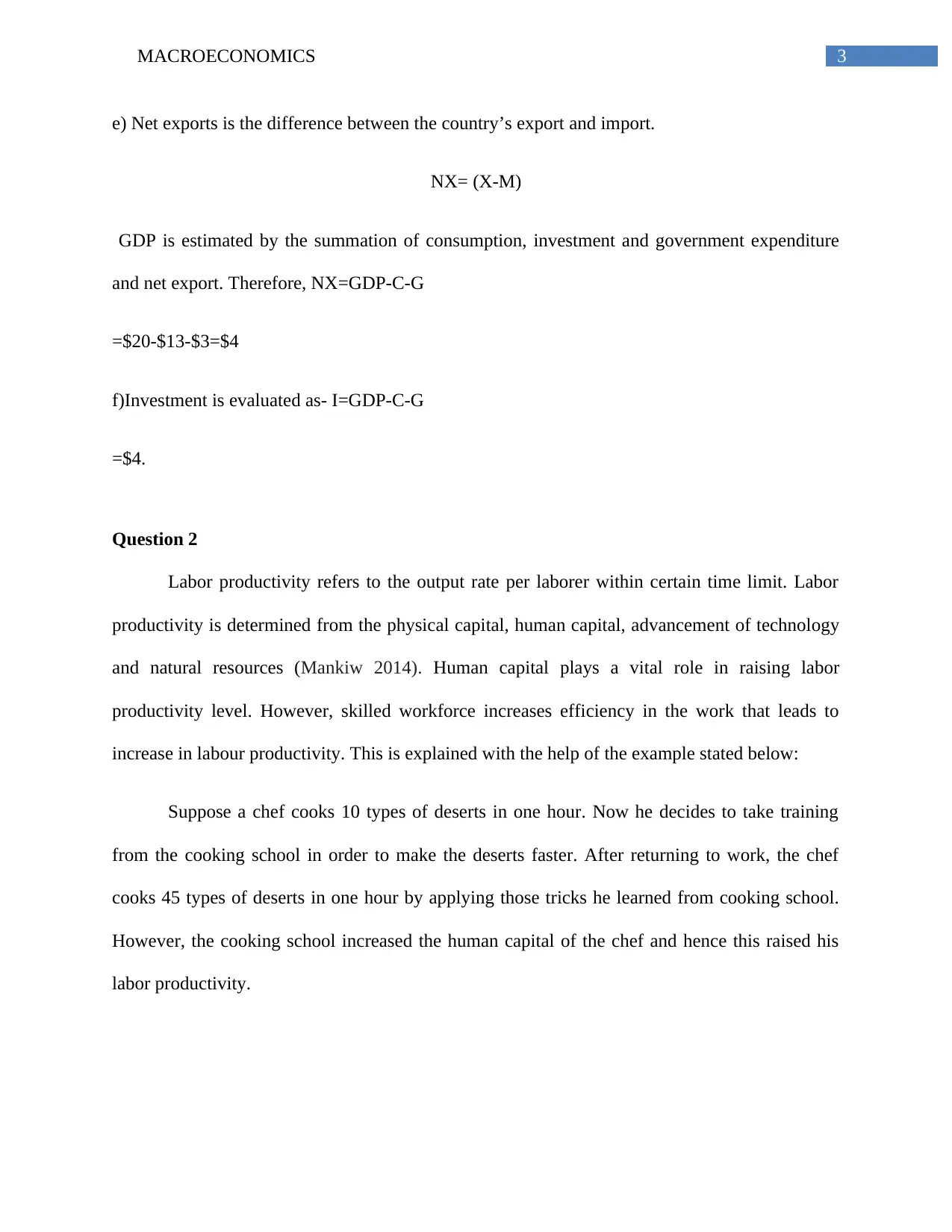
3MACROECONOMICS
e) Net exports is the difference between the country’s export and import.
NX= (X-M)
GDP is estimated by the summation of consumption, investment and government expenditure
and net export. Therefore, NX=GDP-C-G
=$20-$13-$3=$4
f)Investment is evaluated as- I=GDP-C-G
=$4.
Question 2
Labor productivity refers to the output rate per laborer within certain time limit. Labor
productivity is determined from the physical capital, human capital, advancement of technology
and natural resources (Mankiw 2014). Human capital plays a vital role in raising labor
productivity level. However, skilled workforce increases efficiency in the work that leads to
increase in labour productivity. This is explained with the help of the example stated below:
Suppose a chef cooks 10 types of deserts in one hour. Now he decides to take training
from the cooking school in order to make the deserts faster. After returning to work, the chef
cooks 45 types of deserts in one hour by applying those tricks he learned from cooking school.
However, the cooking school increased the human capital of the chef and hence this raised his
labor productivity.
e) Net exports is the difference between the country’s export and import.
NX= (X-M)
GDP is estimated by the summation of consumption, investment and government expenditure
and net export. Therefore, NX=GDP-C-G
=$20-$13-$3=$4
f)Investment is evaluated as- I=GDP-C-G
=$4.
Question 2
Labor productivity refers to the output rate per laborer within certain time limit. Labor
productivity is determined from the physical capital, human capital, advancement of technology
and natural resources (Mankiw 2014). Human capital plays a vital role in raising labor
productivity level. However, skilled workforce increases efficiency in the work that leads to
increase in labour productivity. This is explained with the help of the example stated below:
Suppose a chef cooks 10 types of deserts in one hour. Now he decides to take training
from the cooking school in order to make the deserts faster. After returning to work, the chef
cooks 45 types of deserts in one hour by applying those tricks he learned from cooking school.
However, the cooking school increased the human capital of the chef and hence this raised his
labor productivity.
Paraphrase This Document
Need a fresh take? Get an instant paraphrase of this document with our AI Paraphraser
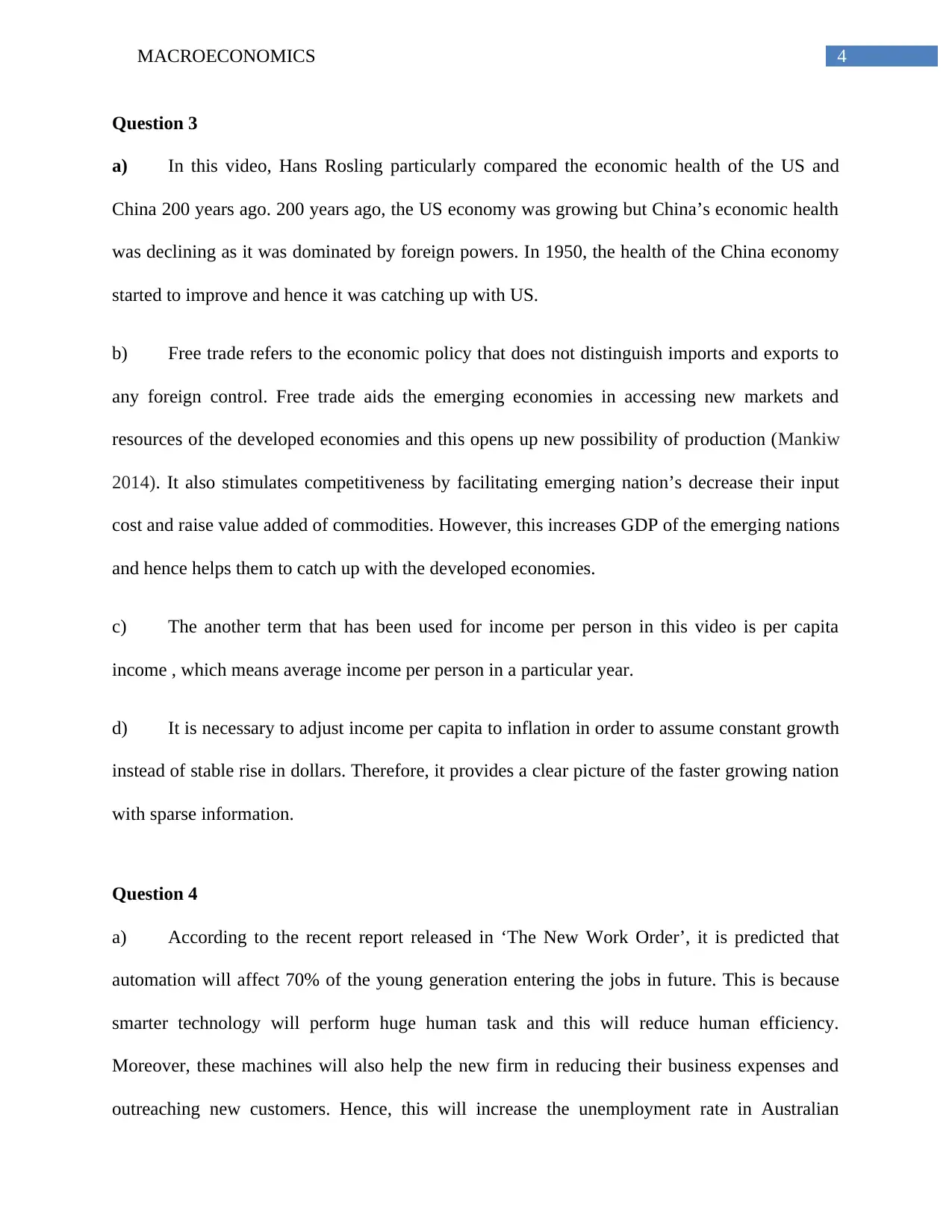
4MACROECONOMICS
Question 3
a) In this video, Hans Rosling particularly compared the economic health of the US and
China 200 years ago. 200 years ago, the US economy was growing but China’s economic health
was declining as it was dominated by foreign powers. In 1950, the health of the China economy
started to improve and hence it was catching up with US.
b) Free trade refers to the economic policy that does not distinguish imports and exports to
any foreign control. Free trade aids the emerging economies in accessing new markets and
resources of the developed economies and this opens up new possibility of production (Mankiw
2014). It also stimulates competitiveness by facilitating emerging nation’s decrease their input
cost and raise value added of commodities. However, this increases GDP of the emerging nations
and hence helps them to catch up with the developed economies.
c) The another term that has been used for income per person in this video is per capita
income , which means average income per person in a particular year.
d) It is necessary to adjust income per capita to inflation in order to assume constant growth
instead of stable rise in dollars. Therefore, it provides a clear picture of the faster growing nation
with sparse information.
Question 4
a) According to the recent report released in ‘The New Work Order’, it is predicted that
automation will affect 70% of the young generation entering the jobs in future. This is because
smarter technology will perform huge human task and this will reduce human efficiency.
Moreover, these machines will also help the new firm in reducing their business expenses and
outreaching new customers. Hence, this will increase the unemployment rate in Australian
Question 3
a) In this video, Hans Rosling particularly compared the economic health of the US and
China 200 years ago. 200 years ago, the US economy was growing but China’s economic health
was declining as it was dominated by foreign powers. In 1950, the health of the China economy
started to improve and hence it was catching up with US.
b) Free trade refers to the economic policy that does not distinguish imports and exports to
any foreign control. Free trade aids the emerging economies in accessing new markets and
resources of the developed economies and this opens up new possibility of production (Mankiw
2014). It also stimulates competitiveness by facilitating emerging nation’s decrease their input
cost and raise value added of commodities. However, this increases GDP of the emerging nations
and hence helps them to catch up with the developed economies.
c) The another term that has been used for income per person in this video is per capita
income , which means average income per person in a particular year.
d) It is necessary to adjust income per capita to inflation in order to assume constant growth
instead of stable rise in dollars. Therefore, it provides a clear picture of the faster growing nation
with sparse information.
Question 4
a) According to the recent report released in ‘The New Work Order’, it is predicted that
automation will affect 70% of the young generation entering the jobs in future. This is because
smarter technology will perform huge human task and this will reduce human efficiency.
Moreover, these machines will also help the new firm in reducing their business expenses and
outreaching new customers. Hence, this will increase the unemployment rate in Australian
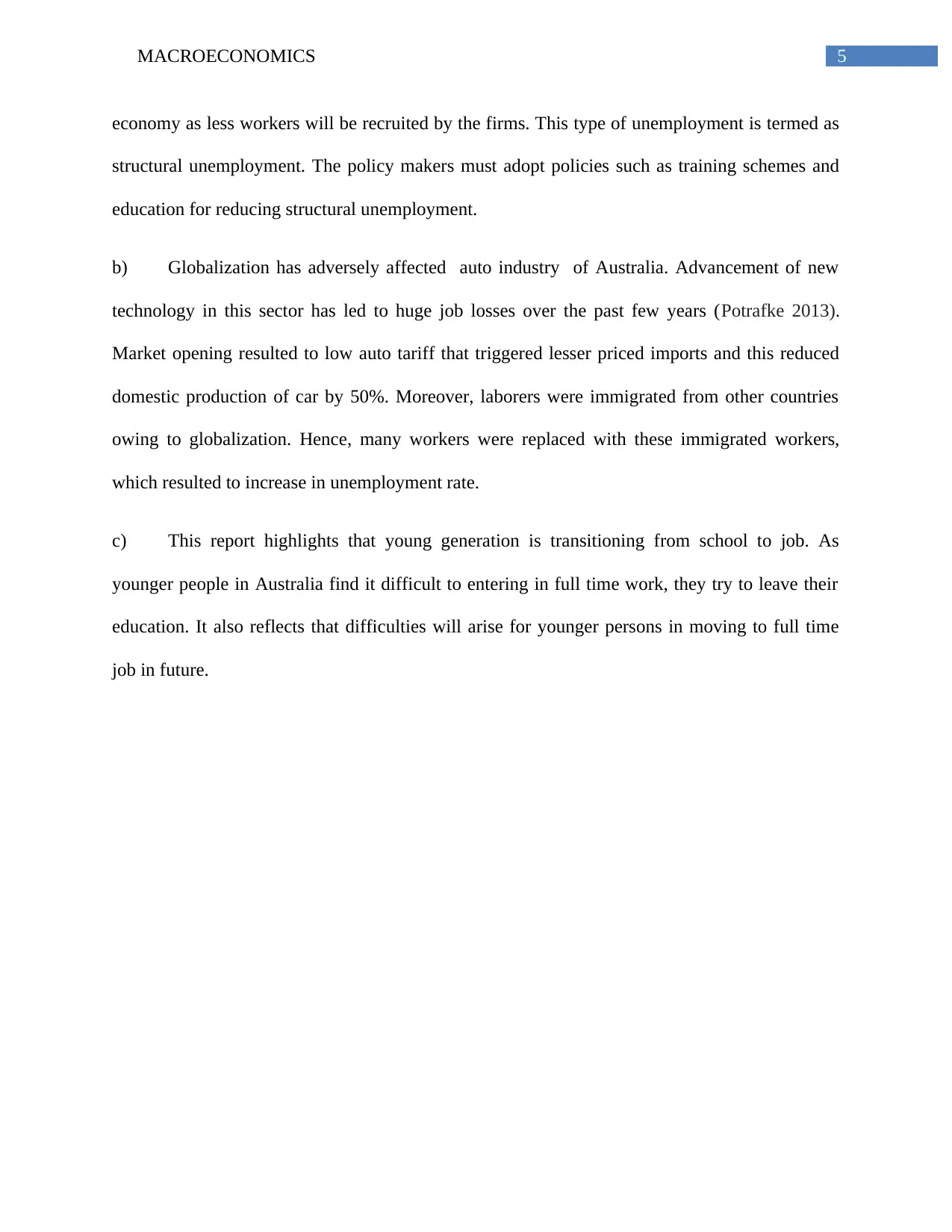
5MACROECONOMICS
economy as less workers will be recruited by the firms. This type of unemployment is termed as
structural unemployment. The policy makers must adopt policies such as training schemes and
education for reducing structural unemployment.
b) Globalization has adversely affected auto industry of Australia. Advancement of new
technology in this sector has led to huge job losses over the past few years (Potrafke 2013).
Market opening resulted to low auto tariff that triggered lesser priced imports and this reduced
domestic production of car by 50%. Moreover, laborers were immigrated from other countries
owing to globalization. Hence, many workers were replaced with these immigrated workers,
which resulted to increase in unemployment rate.
c) This report highlights that young generation is transitioning from school to job. As
younger people in Australia find it difficult to entering in full time work, they try to leave their
education. It also reflects that difficulties will arise for younger persons in moving to full time
job in future.
economy as less workers will be recruited by the firms. This type of unemployment is termed as
structural unemployment. The policy makers must adopt policies such as training schemes and
education for reducing structural unemployment.
b) Globalization has adversely affected auto industry of Australia. Advancement of new
technology in this sector has led to huge job losses over the past few years (Potrafke 2013).
Market opening resulted to low auto tariff that triggered lesser priced imports and this reduced
domestic production of car by 50%. Moreover, laborers were immigrated from other countries
owing to globalization. Hence, many workers were replaced with these immigrated workers,
which resulted to increase in unemployment rate.
c) This report highlights that young generation is transitioning from school to job. As
younger people in Australia find it difficult to entering in full time work, they try to leave their
education. It also reflects that difficulties will arise for younger persons in moving to full time
job in future.
⊘ This is a preview!⊘
Do you want full access?
Subscribe today to unlock all pages.

Trusted by 1+ million students worldwide

6MACROECONOMICS
References
Mankiw, N.G., 2014. Principles of macroeconomics. Cengage Learning.
Potrafke, N., 2013. Globalization and labor market institutions: International empirical
evidence. Journal of Comparative Economics, 41(3), pp.829-842.
References
Mankiw, N.G., 2014. Principles of macroeconomics. Cengage Learning.
Potrafke, N., 2013. Globalization and labor market institutions: International empirical
evidence. Journal of Comparative Economics, 41(3), pp.829-842.
1 out of 7
Related Documents
Your All-in-One AI-Powered Toolkit for Academic Success.
+13062052269
info@desklib.com
Available 24*7 on WhatsApp / Email
![[object Object]](/_next/static/media/star-bottom.7253800d.svg)
Unlock your academic potential
Copyright © 2020–2025 A2Z Services. All Rights Reserved. Developed and managed by ZUCOL.




